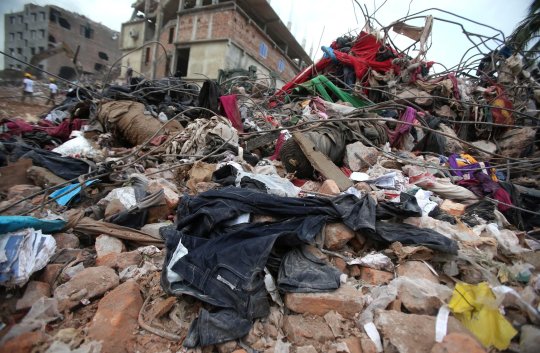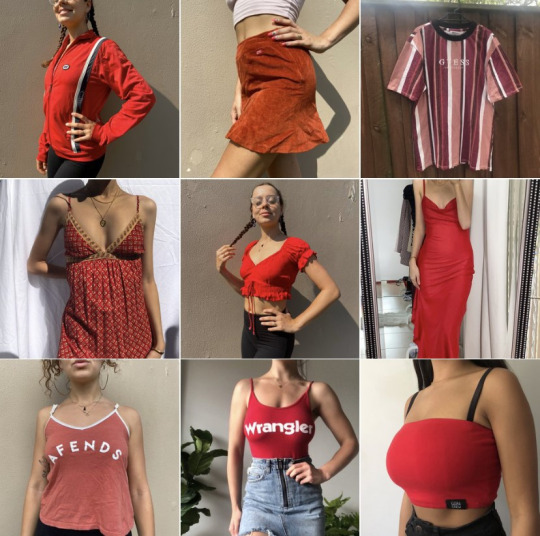#this is demonstrated with the rise in popularity of thrifting and the fast fashion industry
Text
Conventional beauty is capitalist propaganda
#trends and conventional beauty standards are created by fast fashion as means to control the public#as well as encouraging the public to spend their money certain ways#this is demonstrated with the rise in popularity of thrifting and the fast fashion industry#working to replicate thrifting and thrifted item vibes#I could go on
1 note
·
View note
Text
Fast Fashion and Climate Change
I have recently noticed posts circulating on social media about fast fashion and its consequences, so I wanted to explore this further. Years of research have made it evident that the chemical composition of the atmosphere is changing, global temperatures are rising, and precipitation patterns are being altered. These conditions define climate change. There has been a clear correlation between climate change and anthropogenic activities. This indicates that as industrialization progresses, the impact these actions have on the environment will escalate.

Photo retrieved from https://www.scientificamerican.com/article/10-solutions-for-climate-change/
As a capitalist society, we are conditioned into living consumerist lifestyles. Majority of the models behind modern markets are based on maximizing profit. In order to maximize profit, many companies rely on cheap labour and the exploitation of resources (Wainwright, 2010). In recent years, consumerism has rapidly grown in the fashion industry, and fast fashion has become more popular (The price of fast fashion, 2018). Clothing is produced faster, the online shopping craze makes it extremely accessible, and new designs are popping up every day to satisfy the desire to be wearing the latest trends. Studies have estimated that we are buying 60% more than we did in 2000. Yet, each piece of clothing is worn less prior to being discarded. This shorter lifespan is associated with a higher level of manufacturing emissions (Drew & Yehounme, 2017). This high-consumption lifestyle is encouraged in many western countries by heavily advertising the low price of these cheap garments. What they do not advertise is the burden that the production and distribution of their products has on the environment.

Photo retrieved from https://www.euronews.com/living/2020/08/20/welcome-to-the-dark-side-shein-is-the-biggest-rip-off-since-fast-fashion-was-born
The industry of textile production is one of the most significant in pollution contribution. It generates 1.2 billion tonnes of CO2 per year (The price of fast fashion, 2018). To put this into perspective, this produces more emissions than international flights and maritime shipping. Furthermore, a substantial amount of clothing manufacturing occurs overseas in China and India. These countries depend on coal-fuelled power plants, which further increases the amount of pollution emitted to produce each garment (The price of fast fashion, 2018). There has also been a shift in the materials used to produce clothing, and emissions from manufacturing are based on the type of material. Polyester has become one of the most commonly used fabrics in clothing production. The production of polyester and other synthetic materials has a much larger footprint because they are produced from fossil fuels like crude oil (Kirchain et al., 2014).

Photo retrieved from https://www.nytimes.com/2019/09/03/books/review/how-fast-fashion-is-destroying-the-planet.html
A study conducted by Bauck (2017) stated that approximately 5% of total global emissions arise from the fashion industry. This study was conducted in 2017, and since then the fast fashion industry has blown up. Think about companies like fashion nova, prettylittlething, zaful, romwe, and shein. It is almost hard to escape their advertising. Everywhere you look online there is a pop up ad, a try on haul or an influencer on social media promoting these companies. Studies have demonstrated a correlation between materialistic values and carelessness about climate change (Klein, 2014). Thus, we must become aware of the consequences that our actions have in order to prioritize the reduction of emissions and mitigate climate change.
My question to you is:
What are some ways to support sustainable fashion? I understand that sustainable fashion can be expensive but there are ways to avoid the high cost. Personally, I do this by thrift shopping, and using reseller apps like depop.

Photo retrieved from https://medium.com/@morganacarleton/the-downfall-of-fast-fashion-be47272a3b3b
References
Bauck, W. (2017). The fashion industry emits as much greenhouse gas as all of Russia. Fashionista.
Drew, D. & Yehounme, G. (2017). The apparel industry’s environmental impact in 6 graphics. World Resources Institute.
Kirchain, R., Olivetti, E., Reed Miller, T. & Greene, S. Sustainable Apparel Materials (Materials Systems Laboratory, 2015).
Klein, N. (2014). This changes everything: capitalism vs. the climate. Simon & Schister
The price of fast fashion. (2018). Nature Climate Change, 8(1), 1–1. https://doi.org/10.1038/s41558-017-0058-9
Wainwright, J. (2010). Climate change, capitalism and the challenge of transdisciplinarity. Ann. A,. Assoc. Geogr., 100(4), 983-991.
2 notes
·
View notes
Text
The Fast Fashion Industry needs to Slow Down (Week 7)
Slow fashion can often be described as a countercultural movement to the fast fashion industry. The fast-fashion industry is mass-produced, cheap, changes within a fortnight, and often associated with a ‘throw away’ attitude (Watson & Yan 2013). To contrast this, slow, or sustainable fashion refers to those ‘goods and services that respond to basic needs and bring a better quality of life, while minimizing the use of natural resources, toxic materials and emissions of waste and pollutants over the life-cycle, so as not to jeopardize the needs of future generations’ (Lai et al. 2017 pp.83).
The rise of this movement can likely be attributed to an increase in awareness of the environmental and ethical consequences of fast fashion. The global fashion industry accounts for 10% of the world’s carbon emissions, with the fibers and textiles industry producing an estimated 1.2 billion tons of greenhouse emissions in 2015. This exceeds the combined carbon footprint of international flights and maritime shipping (Brewer 2019)! Underprivileged countries are also exploited as garment workers for their cheap labour, leading to abominable working conditions. The 2013 collapse of the eight-story Rana Plaza building in Bangladesh caused the death of 1134 people and injured approximately 2500 others, although sufficient warnings of the building’s lack of safety were given on the day prior and these deaths could have been easily avoided (Brewer 2019).

Photo from Instagram (@ugurgallen)
This topic has been very widely discussed in the media, especially on social media platforms. There are numerous influencers online who inform about the fast fashion industry, critique other influencers who promote fast fashion and demonstrate to viewers how to live more ethically and sustainably. For example, Kristen Leo is a YouTuber who discusses issues including sustainable living, ethical fashion & veganism. Her channel has almost 300 thousand subscribers and her Instagram account, where she discusses similar issues, has upwards of 80 thousand followers. She has videos about her eco-friendly apps, thrifted outfits and sustainability tips.

Slow fashion has also entered the online world through the popular app/website, Depop. The app is described as a “global marketplace” for over 15 million users that allows anyone to sell their second hand clothes from around the world (Depop 2020). This application promotes a more sustainable version of online shopping. Rather than purchasing cheap clothes online from major fast fashion brands, users can find something unique and decently priced, providing it with a second life. It is free to download, and easy to both purchase and sell items.

The $1.78 trillion fast fashion industry has a new threat, the second hand apparel market. Resale has grown 21 times faster than the retail apparel market over the past three years, with the secondhand market estimated to reach $51 billion in four years (threadUP 2019). The more people are educated on and acting upon fast fashion, the greater the slow fashion movement will grow.
References:
Brewer, M 2019, ‘Slow Fashion in a Fast Fashion World: Promoting Sustainability and Responsibility’, Laws, vol.8, no.4, pp.24
Depop 2020, About, viewed 1st May 2020, https://www.depop.com/about/
Lai, Z, Henninger, C, Ryding, D & Alevizou, P 2017, ‘An Exploration of Consumers’ Perceptions Towards Sustainable Fashion – A Qualitative Study in the UK’, in Henninger, E, Alevizou, G & H., Ryding, D (eds), Sustainability in Fashion A Cradle to Upcycle Approach, Springer International Publishing, UK
thredUP 2019, 2019 Fashion Resale Market and Trend Report, viewed 1st May 2020, https://www.thredup.com/resale?tswc_redir=true
Watson, M, & Yan, R 2013, ‘An exploratory study of the decision processes of fast versus slow fashion consumers’, Journal of Fashion Marketing and Management, vol.17, no.2, pp. 141–159
6 notes
·
View notes